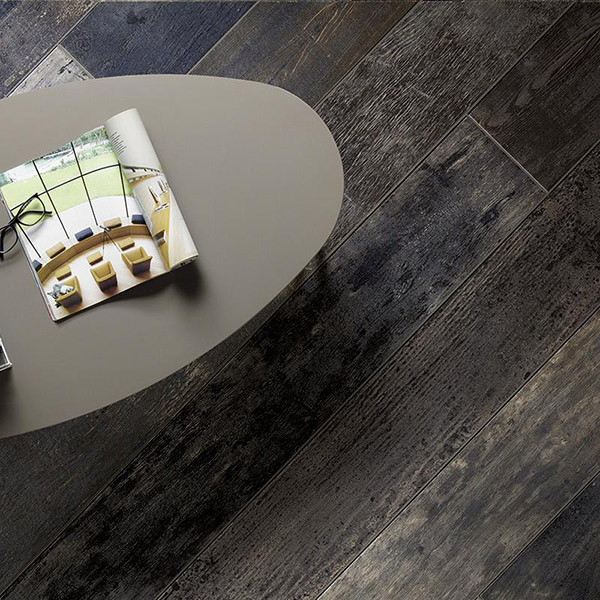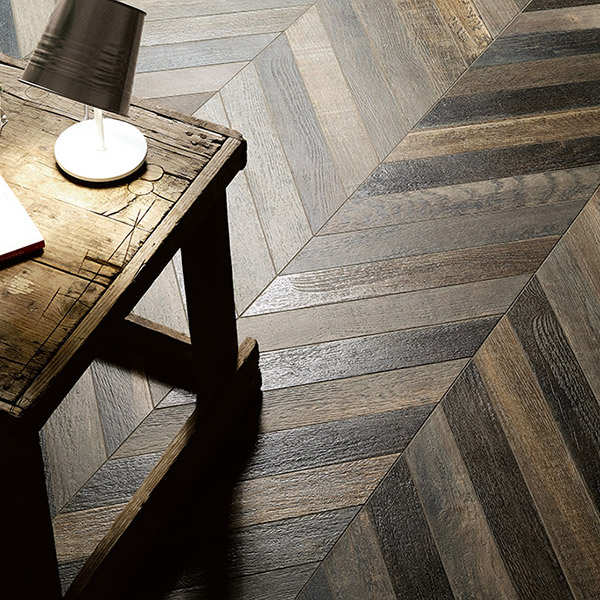Our ‘Oriental Opulence’ design insight touched briefly on Shou-sugi-ban – the ancient Japanese art of the charring wood. It is a technique that is recreated in the new Lapicida Fusta porcelain range of floor and wall tiles.



What does ‘Shou-sugi-ban’ mean. Its literal translation is ‘burnt cedar’ or Japanese cypress wood. Interestingly, Shou-sugi-ban is also sometimes referred to as ‘Yakisugi’ with ‘Yaki’ meaning to heat with fire.
Why Burn Wood?
Timber planks are charred on the outward face not for decoration, but to actually prolong the life of the wood. In Japan, it is a standard cost-effective building material. Specifically, the process involves burnishing the outer face of the wood. As there are no chemicals involved, it is an environmentally responsible way of preserving timber.
So how effective is it? Cedar or cypress wood treated using Shou-sugi-ban can last many years longer than the same, but untreated, wood, especially in an outdoor setting.
Ancient Beauty
There is nothing new about this technique, in fact, tradition dates back to the 1700s when it was invented to extend the life of wood. However, craftsmen also discovered that it created a uniquely beautiful look – something we at Lapicida aspire to.
The charring process makes the wood naturally more resistant to fire, insect infestation and decay. It also helps the wood deal with mother nature by protecting it from the elements including sun, wind and water. These are some of the key reasons as to why architects and designers in the west are so attracted to this method.
The art of Shou-sugi-ban did however decline in Japan in the 20th century when wood was in relatively scarce supply and it proved too expensive to import timber. New materials, including plastic and concrete became more popular.
Relighting Interest
The ‘Yakisugi’ look has had a real resurgence, predominantly in the west, for aesthetic reasons rather than its preservative properties. Today, it is an extremely desirable contemporary ‘high design’ style that evokes nature and simplicity when used on the exteriors of buildings. It also adds warmth and elegance to interior spaces. Another positive is that the very nature of the process also fulfills our growing demand for sustainable residential and commercial building materials.
The characteristics of charred wood are intriguing. They lend a sense of mystery to both contemporary and traditional interiors and exteriors. Website ‘Curbed’ has 7 gorgeous black timber homes to swoon over whilst the New York Times ran this fascinating piece ‘The Latest Design Trend: Black and Burned Wood’.
Recreating The Look
Whilst it may look simple, Shou-sugi-ban is actually difficult to recreate without the right skills. Trying to fake it with paint or wood stains simply doesn’t cut it as they are neither effective, long-lasting or authentic.
Step forward a new generation of porcelains that have been devised, especially to recreate the charred or carbonised wood look for interiors, but with many practical advantages.
Porcelain has much greater design flexibility than wood, which opens up a whole spectrum of different achievable shades from silver-white to dark rose and black.
The inherent durability and low maintenance of Shou-sugi-ban effect porcelain also expands the use of such surfaces to include floor and wall tiles for kitchens, bathrooms and living spaces, as well as commercial projects.
Three entirely new Lapicida porcelain ranges bring the ancient art of Shou-sugi-ban into the 21st century. Lapicida Fusta is a trio of porcelains with the textured appearance of carbonised crackling wood. Ignis has silver, rose and ash variants and is incredibly realistic with crackling detail, knots and nicks. Finally, Lapicida Mixed Wood Chevron has Burnt and Dark options that create a highly contemporary chevron pattern.
Want to explore Shou-sugi-ban further? Why not discuss the options and applications of our wood effect porcelains with a Lapicida expert. Call Lapicida on +44 (0)1423 400 100 or email enquiries@lapicida.com.
For more ‘Shou-sugi-ban’ inspiration, click here to explore our ‘Design Spotlight: Shou-sugi-ban’ Pinterest Board.


